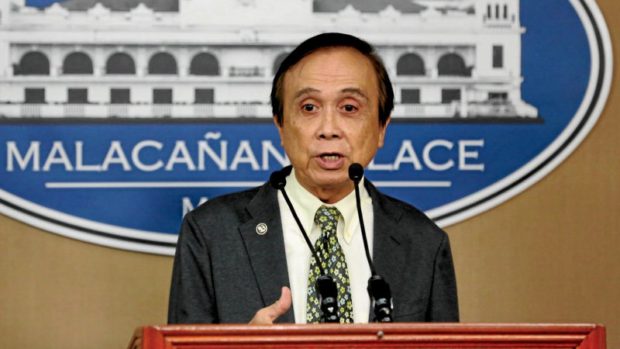Inflation up 2.8% in July

Socioeconomic Planning Secretary Ernesto M. Pernia (File photo by JOAN BONDOC / Philippine Daily Inquirer)
Consumer prices inched up 2.8 percent year-on-year in July, faster than a month as well as a year ago on the back of higher transport costs.
In a report Friday, the Philippine Statistics Authority (PSA) said the rate of increase in prices of basic goods last month rose from 2.7 percent in June and 1.9 percent in July last year.
In a statement, the state planning agency National Economic and Development Authority (Neda) attributed the month-on-month uptick in headline inflation to price increases in the transportation sector.
“Higher prices in the transport sector pushed non-food inflation to 2.4 percent from 1.9 percent in June,” Neda noted.
“The increase in transport price inflation can be traced to the rise in railway transport prices, reflecting the fare hike in July. This was the first fare adjustment in 20 years for the Philippine National Railways,” Socioeconomic Planning Secretary Ernesto M. Pernia explained.
Also, “higher domestic petrol prices, particularly unleaded gasoline, diesel, kerosene, and liquefied petroleum gas, also contributed to faster price increases in the transport sector,” added Pernia, who heads Neda.
As for food inflation, it rose 3.3 percent last month, the slowest since January, on the back of “slower price adjustments for oils and fats, meat, fruit, sugar, honey, vegetables and rice,” Neda said.
“As the Philippines enters its lean months for rice production, it is important for the government to ensure adequate supply of rice to prevent inflationary pressures. Along this line, the planned government-to-private sector rice importation scheme is a step in the right direction. Congress should also act fast to amend domestic laws to end the quantitative restrictions on rice,” Pernia said.
But Pernia cautioned that “dwindling rice stocks could exert upward pressures on food price inflation in the near term.”
As of end-July, inflation averaged 3.1 percent, within the government’s 2-4 percent target range for 2017.
For the Bangko Sentral ng Pilipinas (BSP), it “continues to see a manageable inflation outlook over the policy horizon after taking into consideration the latest inflation reading in July,” BSP Governor Nestor A. Espenilla Jr. said in a statement.
“Inflation is projected to remain close to the midpoint of the national government’s range target of 2-4 percent in 2017 to 2019. The inflation path will be supported by the continued strength of the domestic economy as well as negative base effects in the last four months of 2017,” Espenilla said.
“The within-target path of inflation over the policy horizon provides the BSP with the flexibility to assess our monetary tools to enhance further our responsiveness to the evolving requirements of the economy with due consideration of external factors with potential impact on domestic monetary conditions,” Espenilla added.
The Monetary Board, the BSP’s highest policymaking body, will discuss the monetary policy stance at its meeting on Aug. 10.
Meanwhile, the PSA revised the inflation figure for June to a slightly lower 2.7 percent from 2.8 percent previously.
The PSA explained that it adjusted the June figure as “Lanao del Sur was included in the computation of the consumer price index (CPI) for June 2017.”
“Prices for May were used to impute prices for June for comparability purposes with July as the province was able to conduct price surveys in sample municipalities outside Marawi City in July. As Lanao del Sur was not able to conduct price surveys in Marawi City, its prices were imputed for July based on the price movements of commodities of the nearest province, Lanao del Norte,” the PSA said. Since May, Marawi City is in the middle of armed conflict between government forces and ISIS supporters.
Also, the adjustment in June figure was necessary as the “updated tuition fee from the province of Isabela was included in the computation of CPI for June,” according to the PSA. JPV
